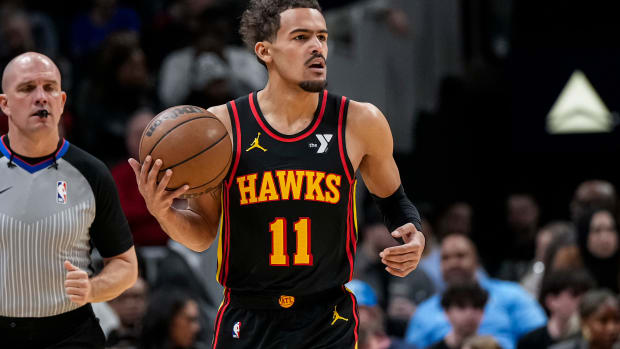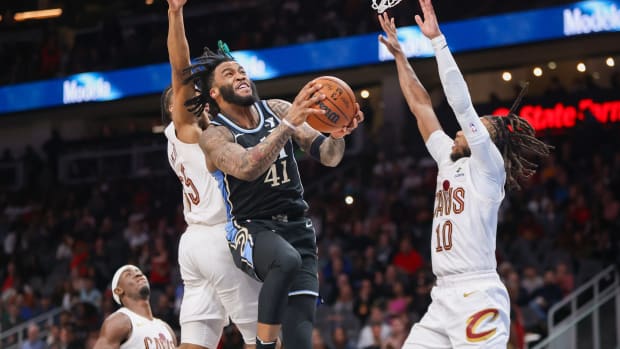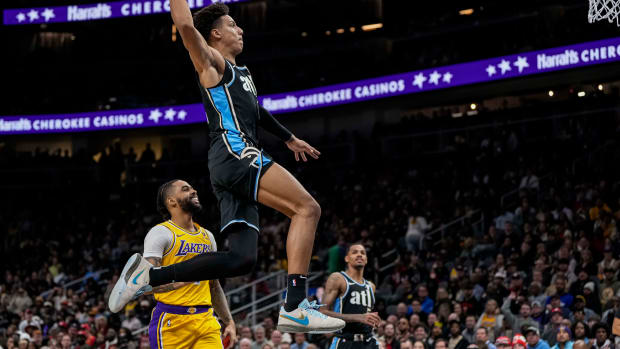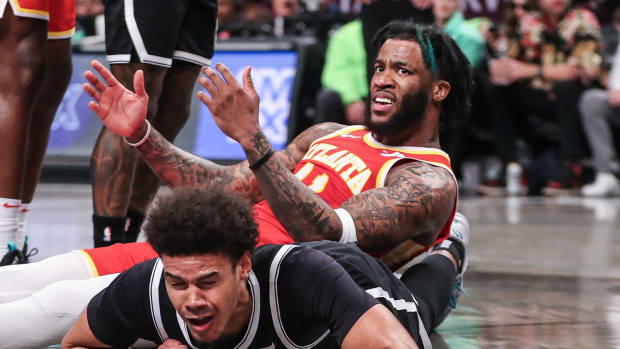Five Observations Through Five Games
The Hawks have reached the first real lull in their schedule, and with four days off between Thursday’s loss to the Heat and Tuesday’s date with the Spurs, it feels like a good time to take stock of Atlanta’s season thus far and offer some early observations. Here’s what stands out from the first five games of the season.
The Trae Young void
It stands to reason that a team would play worse without its best player on the court, especially one as creative and dynamic as Young. But his ankle injury has laid bare an issue that has been lurking beneath the surface for a while: the Hawks are probably over-reliant on their point guard, and have struggled mightily to create offense when he sits. In two games without Young (including the first Heat game, in which he played just 11 minutes), the Hawks have scored 94.1 and 102.1 points per 100 possessions, respectively, according to Cleaning the Glass. Including Atlanta’s first three games, in which he averaged nearly 36 minutes per game, the team has mustered just 92 points per 100. Only Kawhi Leonard and James Harden have posted higher usage rates this season than Young.
Building an offense around a star talent isn’t a bad thing – it is, in fact, quite a smart thing to do. But a franchise needs more structure than just a single player, no matter how talented. That the Hawks don’t yet have the necessary infrastructure around Young isn’t an indictment of the front office or coaching staff (though signing a more capable backup point guard might have helped); despite a promising start to the year, Atlanta is in the early stages of its rebuild, and can’t expect every piece to fall into place immediately. Cam Reddish and De’Andre Hunter have gotten plenty of opportunity to grow their on-ball chops – an experiment that should pay off once they master the reads and timing of the NBA game. Kevin Huerter projects as an ideal secondary playmaker that can space the floor and stretch defenses on the move.
The pieces for Atlanta to eventually become self-sustaining appear to be in the system, they just haven’t developed that independence yet.
The center rotation
Each of Atlanta’s first three games featured an All Star-caliber opposing center, and each feasted on the Hawks’ front line. Rookie Bruno Fernando might be the team’s best center at the moment, though a tweaked ankle has limited his effectiveness as of late. He has the strength (at least up top) to compete down low with giants and enough mobility to provide passable support in pick-and-roll coverages. He has learned the necessary rotations faster than expected and can be a solid deterrent near the rim:
“I think it’s just learning where to be at the right time and the right spot, and just keeping the communication up at all times with my teammates on the floor,” Fernando said. “As a big guy you kind of get to see things a lot more clearly from the back, and being able to call screens and talk to the guards whenever there’s a situation like that.”
He’s slowly working a 3-pointer into his arsenal, and even attempted a step-back triple earlier in the season. If he consistently knocks down shots from the perimeter, he may surpass Alex Len – just 2-of-13 from 3 to start the year – in the rotation.
That may say more about Len and Damian Jones than it does about Fernando (though Bruno has officially become an intriguing part of Atlanta’s future). If he doesn’t hit shots and space the floor, it’s unclear what Len provides offensively. He isn’t good enough in the post to hog possessions on the block and can’t create his own shot from anywhere else on the floor. He has muffed too many passes rolling to the basket and struggled at times to finish the easiest of looks around the basket. His defense is passable, but he isn’t as strong or mobile as Fernando. Jones simply lacks the timing, awareness, instincts, coordination, and fluidity to man an NBA rotation spot right now. He’s constantly a beat slow on defense and isn’t as switchable as his physical tools might suggest. Jones has toyed with shooting corner 3s in practice and warm-ups, but has yet to translate that to games.
The dearth of good options at center could force Lloyd Pierce into playing John Collins and Jabari Parker together more than he’d like. Atlanta’s defense becomes perilously flimsy in those alignments, especially if Young is also involved. If things get bad enough on that end, however, Pierce may decide to lean all the way into offense and live with the defensive consequences.
The rookie curve
The rookie learning curve has gradations and poses different challenges for every player. Experienced, mature college players like Hunter and Fernando have had their foibles, but largely adapted well to the NBA’s speed, length, and physicality. Those two are already operating like veterans in the pick-and-roll – occasionally with one another:
Hunter is far more developed than even Pierce expected, playing solid defense against multiple positions and creating his own offense at a level most rookies of his archetype don’t. His upside as a hyper-versatile defensive weapon will be crucial to rounding out Atlanta’s core, and he may have more upside than initially thought going into the draft. He looks like a first-year at times, but that’s to be expected of even the most NBA-ready rooks. Hunter belongs here.
Fernando’s physical maturity has allowed him to skip some of the steps big men his age must take to earn rotation minutes. He’s mostly aware on defense and knows his role on offense. Fernando doesn’t push too hard when opportunities aren’t there and he knows how to keep the offense moving. He’s a flashier passer than he showed at Maryland:
“I’m not surprised, to be honest,” said Kevin Huerter, Fernando’s former teammate at Maryland. “I think in a lot of ways he can play a lot better, too, and I think he knows that. But he’s still trying to get his feet wet, kind of get in rhythm, get the season going.”
The process has been a bit tougher on Reddish. The wing is more advanced on defense than most expected, particularly as a help defender. Offensively he has struggled to find his footing. He sees the floor and passes well for a rookie, but tends to speed up and make poor decisions. “I gotta slow down,” Reddish said. “Once I slow down, let the game come to me, and just play my game I’ll be perfectly fine. I’m starting to see it a little bit more. It’s coming, and I’m looking forward to that moment.”
He began the year 0-of-14 from 3 before hitting his first on Thursday night and is sporting an unfathomably low 27.9 true shooting percentage. He is perhaps the worst offensive player in the NBA right now. And that’s okay; players like Young, Luka Dončić, and even Hunter have led us to raise our collective expectations for rookies, but those players are still anomalies. Reddish, barely 20 years old, has plenty of physical and mental maturing to do; he has always been more promising as a long-term prospect than a readymade contributor. He deserves time, even if the growing process is painful. “I feel like I’m getting better, getting a little bit more comfortable,” he said. “So I’ll just keep pushing.”
DeAndre’ Bembry, fitting in wherever he can
No matter what function he might be serving on a given night, Bembry does it with full force. His package of passing, ball-handling, and defense makes him Atlanta’s most versatile two-way weapon, and his all-out play style makes him difficult for Lloyd Pierce to take off the court. One night, the Hawks might need Bembry to orchestrate the offense when Trae Young rests (or, lately, sits out). The next he might be shifting momentum with timely offensive rebounds or defensive stops. There isn’t a need Bembry can’t fill (save for outside shooting) or a lineup he can’t mesh with.
Atlanta has still been outscored with Bembry on the court this season and he isn’t the sort of talent who will singlehandedly carry teams to victory. But he can help take a team over the top, and it will be interesting to see what his contributions mean for a team that has its star back. His shooting limitations could become a concern against certain opponents, but as long as the rest of his output outweighs those shooting and spacing constraints, Bembry could still be an integral part of Pierce’s plan for the season.
A slightly less efficient shot profile
The Hawks outperformed their talent level last season in part because they generated one of the most efficient shot diets in the NBA. Just under 40 percent of their attempts came at the rim and over 10 percent were corner 3s – the fourth-best mark in the league. Even if a team doesn’t make a high percentage of those shots relative to the rest of the NBA, they are inherently more efficient looks than mid-rangers or above-the-break triples; Atlanta earned extra points simply by hunting the most efficient shots and living with mediocre results. As a result, the Hawks led the NBA in pbpstats’ shot quality metric, but fell way short of its expected return on field goal attempts.
They’ve only played five games this year, but Atlanta hasn’t been quite as successful finding those shots in 2019-20. It still takes nearly 39 percent of its shots at the rim, but ranks 20 in the league in corner 3 attempts and 15 in total 3-point tries, according to Cleaning the Glass. The Hawks’ mid-range frequency is up – partly a result of opponents making a more concerted effort to take away Young’s 3s and drives – and their 3-point accuracy down. That combination makes it all the more tough for a team with severe turnover issues to stay afloat offensively. Without its offensive rudder, Atlanta has felt the effects over its last two games.





